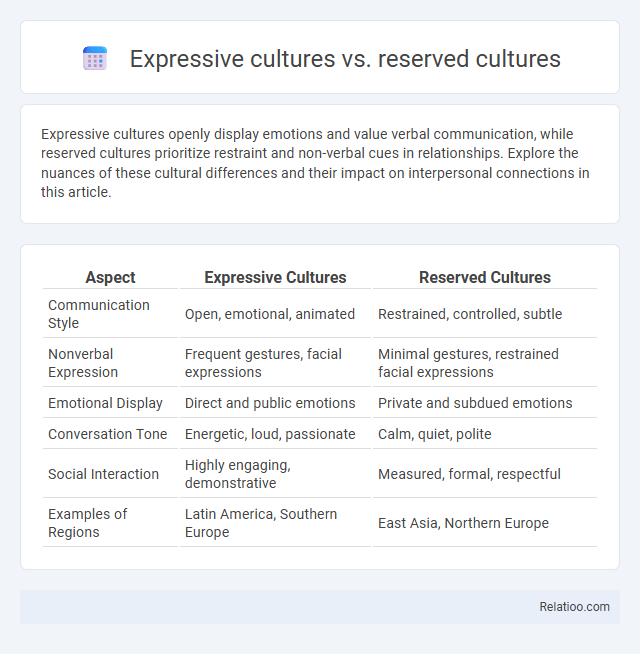Expressive cultures openly display emotions and value verbal communication, while reserved cultures prioritize restraint and non-verbal cues in relationships. Explore the nuances of these cultural differences and their impact on interpersonal connections in this article.
Table of Comparison
| Aspect | Expressive Cultures | Reserved Cultures |
|---|---|---|
| Communication Style | Open, emotional, animated | Restrained, controlled, subtle |
| Nonverbal Expression | Frequent gestures, facial expressions | Minimal gestures, restrained facial expressions |
| Emotional Display | Direct and public emotions | Private and subdued emotions |
| Conversation Tone | Energetic, loud, passionate | Calm, quiet, polite |
| Social Interaction | Highly engaging, demonstrative | Measured, formal, respectful |
| Examples of Regions | Latin America, Southern Europe | East Asia, Northern Europe |
Understanding Expressive and Reserved Cultures
Expressive cultures, such as those in Latin America and Southern Europe, openly display emotions through gestures, tone, and facial expressions, fostering direct interpersonal connections. Reserved cultures, common in East Asia and Northern Europe, emphasize emotional control and subtle communication, valuing harmony and restraint to maintain social equilibrium. Understanding these cultural differences enhances cross-cultural communication by acknowledging how emotional expression influences social interactions and relationship-building.
Key Characteristics of Expressive Cultures
Expressive cultures are characterized by open and vivid emotional communication, where individuals freely display their feelings through gestures, facial expressions, and tone of voice. They prioritize direct verbal and nonverbal interaction to convey enthusiasm, agreement, or disagreement, often resulting in dynamic and animated social exchanges. Key characteristics include high levels of emotional expressiveness, spontaneous reactions, and valuing warmth and empathy as essential components of social interaction.
Key Traits of Reserved Cultures
Reserved cultures emphasize restraint in emotional expression, valuing privacy and maintaining composure in social interactions. Key traits include limited verbal and nonverbal displays of feelings, preference for indirect communication, and a strong emphasis on harmony and respect for social hierarchy. Individuals from reserved cultures often prioritize self-control and thoughtful reflection over spontaneous emotional responses.
Communication Styles: Direct vs Indirect
Expressive cultures favor direct communication styles where emotions and opinions are openly conveyed to ensure clarity and build trust. Reserved cultures lean toward indirect communication, emphasizing subtlety and context to maintain harmony and avoid confrontation. Your ability to navigate these differences enhances interpersonal interactions and fosters effective cross-cultural communication.
Emotional Expression in Social Interactions
Emotional expression in social interactions varies significantly between expressive and reserved cultures, influencing communication styles and social dynamics. In expressive cultures such as Italy or Brazil, individuals openly display emotions like joy, anger, or sadness through facial expressions, gestures, and tone, facilitating a direct and engaging interaction. Conversely, reserved cultures like Japan or Finland emphasize controlled emotional expression to maintain harmony and respect, where subtle cues and context are crucial for interpreting feelings during social engagements.
Attitudes Toward Personal Space and Touch
Expressive cultures typically embrace close personal space and frequent, affectionate touch as natural forms of social interaction, reinforcing emotional connections and openness. Reserved cultures maintain larger personal bubbles with minimal physical contact, valuing privacy and emotional restraint to communicate respect and self-control. Understanding your cultural context helps navigate these differences, ensuring respectful and comfortable interactions across diverse social settings.
Conflict Resolution Approaches
Expressive cultures often approach conflict resolution through open emotional expression, valuing direct communication and visible feelings to address misunderstandings quickly. Reserved cultures prefer indirect methods, using subtle cues and maintaining harmony by avoiding overt displays of emotion or confrontation during conflict resolution. Emotional expression in conflict can influence the effectiveness of resolution strategies, where expressive cultures see emotion as a tool for clarity, while reserved cultures prioritize controlled dialogue to preserve relationships.
Effects on Workplace Dynamics
Expressive cultures typically encourage open emotional communication, fostering transparent feedback and stronger interpersonal connections in the workplace, while reserved cultures promote restraint, which can lead to misunderstandings or perceived lack of engagement among colleagues. Emotional expression in diverse teams influences conflict resolution styles, with expressive individuals favoring direct confrontation and reserved individuals preferring indirect communication, impacting collaboration and decision-making efficiency. Understanding these cultural dynamics enhances leadership strategies, improves team cohesion, and supports the development of inclusive organizational policies that accommodate varying emotional expression norms.
Cultural Adaptation and Misunderstandings
Expressive cultures, such as those in Mediterranean or Latin American regions, openly display emotions through gestures and vocal intonations, facilitating transparent communication but potentially overwhelming reserved cultures, like many East Asian societies, where emotional expression is subtle and controlled to maintain group harmony. Cultural adaptation requires recognizing these differences to prevent misunderstandings, as expressive behavior may be misinterpreted as aggression or insincerity by reserved cultures, while reserved responses might seem aloof or disengaged to expressive individuals. Effective intercultural communication hinges on developing emotional intelligence and empathy to bridge these diverse norms and foster respectful interactions.
Building Bridges Between Expressive and Reserved Cultures
Building bridges between expressive and reserved cultures requires understanding diverse emotional expression norms to foster effective communication and mutual respect. Recognizing that expressive cultures display emotions openly while reserved cultures value emotional restraint helps tailor interaction strategies, promoting empathy and reducing misunderstandings. Facilitating cultural competence and dialogue encourages collaboration and trust, enhancing cross-cultural relationships in personal and professional settings.

Infographic: Expressive cultures vs Reserved cultures
 relatioo.com
relatioo.com